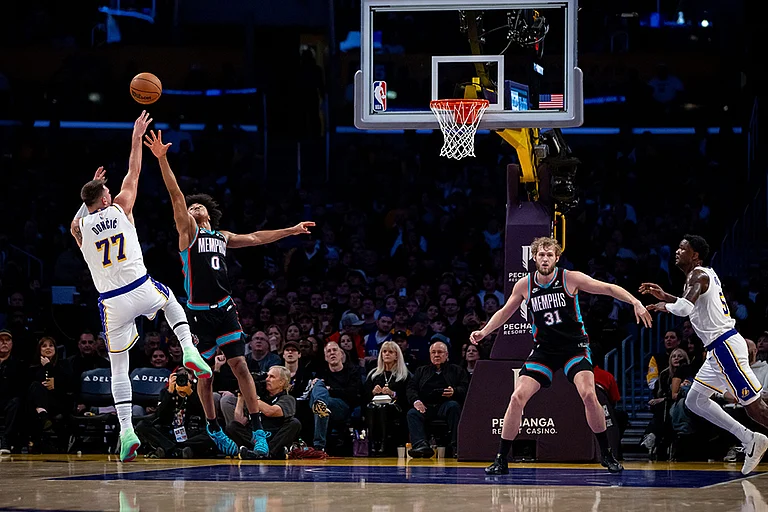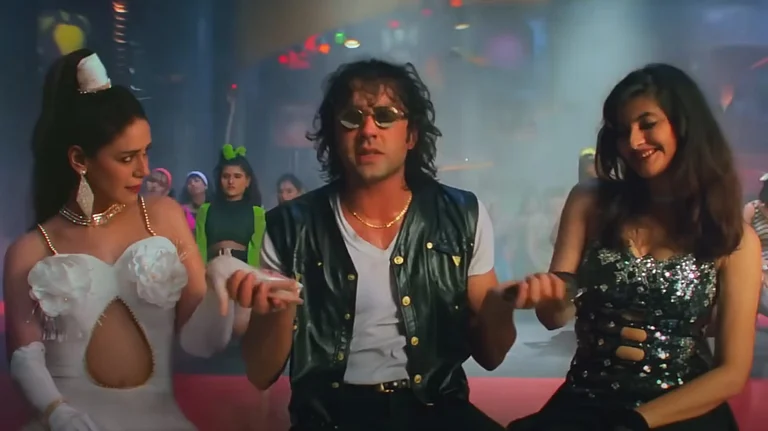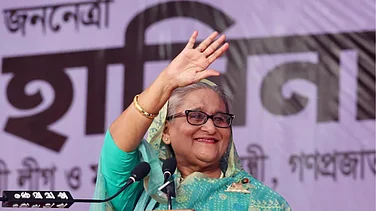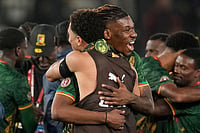Eight years after the Yevgeny Prigozhin-led Wagner Group helped the Russian government cement its rule in Ukraine’s Crimea, it captured a Russian military headquarters, shot down Russian military aircraft, and marched to the capital city of Moscow last week.
By the time a deal was struck between Prigozhin and the Kremlin, the Wagner Group column was within 200 kms of Moscow. To put it into context, imagine a private military marching to Delhi from the Northeast and reaching unopposed as close as Agra.
While the defiant Wagner uprising and stunning pace of march to Moscow shocked the world, it was not entirely unpredictable. Prigozhin had long thrashed the Russian defence leadership and some experts had said it was only a matter of time before the war of words escalated into a conflict on the ground.
The dramatic day-long mutiny of Prigozhin began on Friday and ended late on Saturday when a deal was brokered between him and the Kremlin with the help of Belarusian President Alexander Lukashenko.
Wagner mutiny timeline: The 24 hours that shook Russia
While there was a long road to Prigozhin’s rebellion, he claimed that the immediate trigger was a Russian military attack on Wagner personnel.
After claiming that Wagner personnel had been attacked by the Russian military, Prigozhin said that he was marching with his private military on a “march for justice” to overthrow the Russian defence leadership. Defence Minister Sergei Shoigu and General Staff chief Gen. Valery Gerasimov were the targets.
Friday
In a series of messages, Prigozhin threatened an armed rebellion. He said he would “go to the end” to stop the Russian defence leadership’s “evil”.
In his messages, he questioned the invasion of Ukraine and criticised Shoigu for “poorly planning” the war and “embarrassing” the Russian military, according to The Moscow Times.
“Shoigu killed thousands of the most combat-ready Russian soldiers in the first days of the war...The mentally-ill scumbags decided ‘It’s okay, we’ll throw in a few thousand more Russian men as cannon fodder. They’ll die under artillery fire, but we’ll get what we want'. That’s why it has become a protracted war,” said Prigozhin, as per The Moscow Times.
Prigozhin insisted his military march was “not a military coup” and did not “interfere with the troops in any way” and said that he was targeting the military brass, pointing at Shoigu, according to The Telegraph.
“There are 25,000 of us and we are coming to sort things out...Those who want to join us, it’s time to finish with this mess,” Prigozhin was quoted as saying.
Prigozhin also called upon the members of the Russian military to revolt against their leaders and join his march.
“We don’t fight children. Shoigu kills children. He put 18-year-old boys against us. These guys will live and go back to their mothers. But we will destroy everything that gets in the way,” The Telegraph quoted Prigozhin as saying.
Following Prigozhin's threats, Russia was put on a high alert and security in Moscow was beefed up. Counter-terrorism emergency was imposed in Moscow and Voronezh regions. The Russian FSB opened a criminal case against Prigozhin and charged him for mutiny that carries a 12 to 20-year-sentence.
Prigozhin's rebellion was on.
Saturday
1 am: Putin was briefed at around 1 am about the “attempted armed rebellion”, according to ABC News.
By that time, Prigozhin's Wagner Group personnel had entered the key Russian city of Rostov-on-Don, which houses the headquarters of the Russian military overseeing the Ukraine war efforts. A statement from the Kremlin at the time termed it a “rebellion” but did not name Prigozhin.
7:30 am: Prigozhin claimed control of Rostov-on-Don and the Russian military headquarters there.
Visuals of the Wagner military vehicles, including tanks and armoured carriers, surfaced on social media.
In a message, Prigozhin announced that Wagner personnel would now march to Moscow.
“We will destroy anyone who stands in our way...We are moving forward and will go until the end,” said Prigozhin as he announced Wagner personnel’s march to Moscow under their “march for justice”.
9:30 am: Wagner personnel were well on their way to Moscow by then. During this time, they were targeted by Russian military aircraft and there were reports that the Wagner personnel had shot down a number of Russian military aircraft. Later, Prigozhin confirmed this.
10 am: In his first reaction since Prigozhin’s revolt began, Putin addressed the nation and termed the mutineers traitors.
Putin said that “those on path of treason” would be punished and termed the revolt a “stab in the back”. He called the rebellion a “mortal” threat to the Russian state.
The CNN reported, “Putin said the country had been ‘betrayed by those who are trying to organise a mutiny, pushing the country toward anarchy and fratricide’. He said ‘excessive ambition and vested interests have led to treason’. Putin said it was a ‘blow to Russia’, adding, ‘internal turmoil is a mortal threat to our statehood, to us as a nation’."
10 am-5 pm: The Wagner personnel had reached within 480 kms of Moscow by 5 pm, according to ABC News.
The convoy largely passed unopposed except for certain Russian military air attacks that resulted in helicopters being shot down by Wagner.
During this time, as Wagner marched to Moscow, Putin’s ally and Chechan leader Ramzan Kadyrov said he had dispatched his troops to intercept Wagner personnel on the way to Moscow. Photographs of Chechen convoys also surfaced on social media.
There were also reports, which could not be independently confirmed, that Chechan special forces personnel had by this time reached the Moscow region to bolster the Russian military’s defence against potential confrontation with Wagner personnel.
Kadyrov termed Prigozhin-led Wagner’s mutiny as a “hideous betrayal” and pledged support to Putin.
8 pm: Prigozhin announced that he had ordered the Wagner personnel to halt their march to Moscow.
By that time, the Wagner personnel had reached within 200 kms of Moscow.
Later, a deal was announced between Kremlin and Wagner Group, under which Prigozhin would go to Belarus, all charges against him and mutineer Wagner personnel would be dropped, and Wagner personnel would be offered Defence Ministry contracts.
Prigozhin said that he ordered his soldiers to halt and turn around to stop “shedding Russian blood”. In a statement issued a day later, he said that the march to Moscow was a “demonstration of our protest” against the “injustice” from the Russian defence leadership and not an attempt to overthrow the government.
“The goal of the march was to not allow the destruction of the Wagner private military company and hold to account the officials who through their unprofessional actions have committed a massive number of errors. Society demanded it,” said Prigozhin in an 11-minute statement.
The long road to Wagner mutiny
The Wagner Group's mutiny was neither sudden nor entirely unpredictable.
The Russian elite, particularly in the military leadership circles, had been feuding for a long time and experts said that it was only a matter of time before their war of words turned into a confrontation on the ground.
Earlier, Prigozhin had accused the Russian defence leadership, particularly Defence Minister Shoigu, of poor operations in Ukraine and withholding essential supplies like ammunition from reaching the frontlines. He frequently went into expletive-laden messages against Shoigu and General Staff chief Gen. Gerasimov.
When the Russian government mobilised soldiers last year, The Moscow Times reported that Prigozhin said that “scumbag” Russian military personnel should be mobilised in place of civilians. Later in January-February, he called the military bureaucracy “monstrous” and said that the slow-progressing Russian military was attempting to “steal” Wagner’s victories. Slamming the low supply of ammunition, Prigozhin said “this can be equated with high treason”.
In May, Prigozhin said that the Wagner Group was soon going to cease to exist and again called the Russian military leaders “scumbags” for not providing them with ammunition.
“All the stories about preventing the Ukrainian reserves from entering Bakhmut are total crap. Not a single shot was made by the Russian Army. Nobody is giving them ammunition. Not to them, not to us. A criminal order was made not to give out ammunition...Ammunition is stacked high in warehouses as I already said before. Scumbags who made these decisions should be answerable to the mothers of those killed in action,” The Drive quoted Prigozhin as saying.
Wagner's revolt was also not directly aimed at Putin, says Swasti Rao, Associate Fellow, Europe and Eurasia Center, Manohar Parrikar Institute for Defence Studies and Analyses (MP-IDSA).
“First things first, it was not a coup against Putin. It was the result of a long-drawn power struggle between PMC Wagner’s chief Prigozhin and the Russian Ministry of Defence,” says Rao.
Blow to Putin's ironclad grip, setback to war-efforts
Prigozhin's rebellion and the march to Moscow emerged as the most serious threat to the authority of Putin, who has been at the helm of Russia for 23 years.
While the revolt ended without widespread fighting, the very fact that the revolt happened highlights the failure to control the feuding ruling Russian elite and points at weakening of hold over the factions within the Russian oligarchy, say experts.
“I'm not sure if it was a coup specifically against Putin. Perhaps, this is a showdown between the elites, for example, against Defence Minister Shoigu. However, it shows the weakness of the Russian government. Even if Putin was not the target of this coup attempt, the fact that the elite are fighting among themselves, ignoring the consequences for his authority, speaks volumes,” says Kseniya Kirillova, an analyst at the Washington DC-based think tank Jamestown Foundation.
Rao of IDSA says “there is no way under the sun” that he would have done it without strong internal support.
Rao tells Outlook, “Prigozhin would have never rebelled if he didn’t know for sure that he would get away with it. In my assessment, he has the support of a certain section within the Russian FSB. His confidence and daring drew from at least some support from FSB, a section of Russian oligarchs, and a certain section of Russian public. It is indeed strange that despite his long and aggressive verbal campaign against the Russian MoD, he still survived and thrived without any fear of being terminated that never happened. His Wagner forces marched to Rostov-on-don with no opposition from the Russian army, special forces, or police.”
Even when the Russian military made an attempt, Prigozhin's troops repulsed the attacks and faced no consequences.
Rao tells Outlook, “After capturing Rostov, Prigozhin led the column to Moscow and reached within 200 kms of it where on his way when the Russian army tried to stop him, the Wagner shot down army helicopters and even an army plane. But instead of pressing any charges, a quick compromise was reached providing Wagner troops amnesty, offering them to join the Russian army, and asking Prigozhin to operate from Belarus instead of Russia. This shows that his rebellion had credible support within the Russian establishment that not only allowed the unthinkable to happen but also protected the mutineers and their leader from any criminal charges. ”
While the target of the rebellion was not Putin, something that Prigozhin also confirmed after reaching a deal with the Kremlin, Rao says that the episode has “seriously dented the invincibility of Putin and infallibility of the Russian state”. In the tussle with the Russian MoD over private military companies signing contracts, by going to Belarus, Prigozhin has effectively got what he wanted.
Rao tells Outlook, “Forget being tried and punished for treason, Prigozhin or his fighters were not even fined 10 rubles for making a mockery of the country’s defence establishment. All charges against him were dropped and he was asked to go to Belarus scot-free. One major point of tussle between Prigozhin and MoD was the MoD’s recent directive to all private military companies to sign contracts with the MoD. This was unabashedly refused by Prigozhin who openly defied the directive. Now that Prigozhin and some Wagner troops have been moved to Belarus, they can register there and bypass the requirement of signing Russian MoD contracts. It definitely does not look like a punishment for treason against the Russian state. Prigozhin has got away with defying the MoD and launching an armed rebellion against the ruling elite. How this impacts his crusades in Africa and the Middle East will be revealed in time. However, the armed rebellion and its handling has shown the vulnerability of the Russian state apparatus and has posed serious questions on the iron-hand control that the world thought Putin had.”
Prigozhin's rebellion is a setback to Russian war-efforts in Ukraine and to the ruling style of Putin as it showed that the internal conflicts could not be contained, says Nalin Kumar Mohapatra, Assistant Professor, Centre for Russian and Central Asian Studies, Jawaharlal Nehru University (JNU).
Mohapatra notes that the rebellion came at a crucial moment in the Ukraine War and Russia “no longer has an upper hand and Ukraine has got a tactical benefit” from the recent developments. He adds that Russia is expected to make a short-term retreat.
As for what led to the mutiny, Mohapatra says that it was a fallout of internal squabbling among the Russian ruling elite.
While Mohapatra says that the mutiny and the march to Moscow is definitely a setback to war-efforts and a blow to Putin’s leadership, he says that the President of Russia can also emerge stronger out of the ongoing developments.
Explaining his line of thinking, Mohapatra says that Putin has a circle of oligarchs around him —the Russian elite— that draws its power from him, not the other way around, and he ensures that no one oligarch or faction acquires too much power.
Mohapatra tells Outlook, “Putin does not want any one powerful person to emerge around him. He does not want power to be consolidated in one person. He does not want any centre of power other than himself. To ensure this and to keep power decentralised, Putin allows feuds within the Russian ruling elite so that the elite weaken each other and no one ever becomes powerful enough to challenge his authority.”
Rao of IDSA says that Putin and the Russian oligarchs have a symbiotic relationship and not a top-down relationship. Since no Russian oligarch criticized the armed mutiny while it was unfolding, it also shows that there is at least some waning of support to the Ukraine war within the oligarchs too. Perhaps the most credible explanation is the financial losses from thousands of sanctions imposed by the West.
The biggest outcome of Prigozhin’s mutiny and Wagner’s march to Moscow is the display of cracks in the Russian political and defence elite and Putin’s hold on power to the entire world, says Rao, adding that while there were indications that Putin did not have an absolute control that he was often thought to have, the mutiny laid bare Russia’s faultlines.
Rao says, “The relationship of Putin and the oligarchy is not a top-down relationship, but a symbiotic relationship. One of the reasons why the Russian invasion of Ukraine is a ‘strategic blunder’ for Putin is that it has turned a credible section of the Russian oligarchy against him. The West has imposed sanctions on hundreds of Russian oligarchs and officials who have seen their assets and businesses frozen because of Putin’s war. Regardless of the Ukraine War’s outcome, these oligarchs know that the sanctions are not going away. This is why there is a growing feeling that supporting Putin’s war efforts is no longer in their economic favour.”
As for the road ahead, Rao says that the dust has not yet settled. Now that the world sees a weakened Putin with deep internal division, a realignment with Russia and its leader of over two decades is also on the cards.
Rao tells Outlook, “The world now sees Putin and Russia in a new light. It will realign accordingly. The West does not want the situation to get dangerously out of hand. Most countries have officially called this Russia’s internal matter. Moscow is also in a hurry to show that its business as usual. Without a powerful leader at the helm, the friction among the competing forces within Russia, as revealed by the short lived rebellion, could lead to further disintegration and disarray. The world cannot afford a headless Russia, the largest nuclear power in the world. It would be a very problematic scenario not only for Europe but for the world and also for India. Despite the reputational damage, I would expect that steps will be taken to salvage the situation.”


























